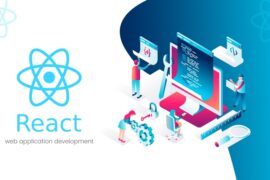DevOps represents a culture and a concept to bring together otherwise divided disciplines of development and operations to deliver a better software product for enterprise purposes in a quicker time.
DevOps boasts a more agile process focused on shorter development span and enhanced efficiency. In a London Web Design Agency DevOps development environment several processes ranging from the designers, programmers, QA testing and analysis, product engineers, and operations experts are integrated and a single collaborative team is created to create a value-based product guaranteeing faster development and improved performance.
In DevOps, simultaneously 4 key processes run concurrently continuously. Here we mention them below:
- Continuous Integration
- Continuous Delivery
- Continuous Testing
- Continuous Monitoring
The Role of Continuous Testing in DevOps
How To Create DevOps Testing Culture
In DevOps agile environment, the testing doesn’t stay waiting to play its role at the end of the development process.
But rather it is brought at the very beginning of the product development cycle and is carried out throughout the project.
As soon as the developers and system engineers finish coding and get it ready for Continuous Integration and Continuous Delivery, Continuous Testing and evaluation process is turned on to validate the code by seeing the functions and performance.
Naturally, the testing team has to Integrate their testing tools and test automation approach with the DevOps environment for the continuous testing process.
Here the testing is continuously carried out not just to ensure the performance of the code but also to make sure that the changes in the code don’t break the product.
An organization can fully automate the entire process starting from the integration, testing, delivery, and monitoring. This fundamental role of concurrent testing in DevOps actually ensures faster product development.
How to Build A Proper DevOps Testing Culture: 3 Ways to Consider
Tools and processes are growing at a rapid speed that makes the team actually work faster speed with better accuracy. But tools alone can not make a team successful. The team needs to be business-oriented, customer-focused and collaborative.
This paradigm shift is required among the teams. There can be pilots to do DevOps before actual DevOps. Teams need to exhibit a culture through shared values, behaviours while working in a cooperative environment.
So a DevOps is all about a culture not about tools. These cultures are about people working together. As people are having different mindsets, if we create N numbers of groups, the culture will differ. Thus incorporating a toolchain not necessarily turn the groups into successful DevOps teams.
What is culture?
Culture is defined as a process to collect ideas, behaviors theoretically. It is easy to define and obtain. In practical, it is equally tough to pinpoint a prospective set of requirements.
Theoretically, the tools are having defined operations and accessible always as constructs but how the group will be using these tools are hard to predict and complex in nature.
Building the Foundation Right
The first and biggest challenge is to make the fundamental right for the DevOps testing culture by preparing the skill set and the participant testing professionals. This involves ensuring the skills of your Quality Assurance (QA) team.
The QA testing team is not only responsible for conducting the automated testing but also for the app building process and the way the testing process makes value addition to the app quality. This is why the QA testers should have a clear idea about the continuous integration process.
Open Communication
A successful DevOps culture is mostly involving dots of a discussion, debate, brainstorming but not like work in a silo, a only interact via a complex ticketing system as and when required. These ticketing systems, rituals of the request process require a higher level of involvement but just kill the processing time.
On the other hand, DevOps talks about more discussion on requirements, features, resource planning, schedules, backlogs etc. It stresses more on product orientation than process or policies.
Responsibility
Responsibility alignment is a very critical aspect of DevOps. Typically, developers are responsible for fixing the bugs but it is seen, that the person who talked about the defect/bug should be assigned along with the developers to get a higher success.
The common responsibility of the team to create an awesome product. Hence, the development team should not be rewarded for writing code and the testing team should not be penalized if the code is not performing well.
However, both teams should be awarded to make an excellent working product.
Ensuring Teamwork
DevOps process focuses on competence by reducing inconsistencies that occur due to redundancy, delays, and dependencies.
Test automation allows robust and coordinated teamwork in the DevOps environment. It ensures in-time feedback generation to take efficient measures to address shortcomings.
This overall measure makes the process more efficient. Testers are expected to share the responsibility of streamlining automation and supporting it right from the very start.
Respect
No team members should be left alone and they should be able to share their views freely without fearing abused and rudely turned down. Essentially, team members do not need to like or love each other, but they must respect the views of each other.
Trust
As there are multiple teams and team members involved, it is extremely important to have trust among team members. Just in case, one part of the team does not trust the other, irrespective of costly tools, the project fails.
Executive support and sponsorship
A top executive must support incentives, compensations and other goodies in order to smoothen the functionality and increase team productivity along with morale. On the other hand, when the top executive supports sponsorship on tools, technologies, the DevOps team flourished.
Technological Leadership
It is important to build leadership among the team like subject matter experts(SMEs), tools experts, code experts and tech buddies. They are the go-to persons once team members stuck somewhere. But they must not do the job for the team members rather they act like counsellor or navigator in the need and drive towards a solution.
mentoring the culture created
It is a top-down and bottom-up approach together. The senior management must reinforce the values and the team members must put them in their blood and follow them.
Driving Continuous Innovation
Finally, in a DevOps environment, it is a compulsion to drive continuous innovation. Helping the team members to try and come with better and more effective practices for testing automation should be a focus area.
Enhancing the technical skills of the testers and helping them to come with new and innovative measures is another responsibility of the project leadership.
This also requires creating more space and time within the workplace and work, to give employees the impetus to work harder and deliver better results.
Besides, rewarding people for the completed jobs, offering some motivation for new skill learning will also work great.
Mindset(Ready,set,go attitude)
While several employees join an organization, they always carry bag and baggage like past experiences, preconceived notions along several prejudices. These are called brake of a process. When applied they create several stresses. They can not come to a common conclusion about an awesome product.
So, team members should put down their baggage with the help of a welcoming team. They must know where to start, what and why they are changing, how these changes will help and who is the customer, what the customer will get in terms of value.
- Perfect Strategy for DevOps Testing
- How To Create DevOps Testing Culture
- DevOps Testing Strategy
The DevOps environment for the projects of a company is likely to have a far-reaching and robust impact on the management and control strategies.
Without a strategy that supervises each and every aspect of the testing process, it is really next to impossible to automate all things in a process.
On the other hand, an automation strategy is required to generate maximum ROI from the project. A good testing strategy is also crucial for faster development and for creating more room for the team to concentrate on other essential tasks.
So, we need to spare some words on various perfect DevOps testing strategies. Well, as per the experience of most successful DevOps projects, we have picked here the below-mentioned testing strategies as the most efficient ones.
Further visit: A Dumb Guide -Does Salesforce Performs DevOps Beyond 2020?
Pick Up the Right Cases for Automation
It is important to know the cases you can choose for automation. Testing automation cases vary from tests with repetitive testing tasks to tests for high-risk projects to testing large data sets and carrying out tests on various environments and browsers.
Obviously, you need to pick the right automation test case based on the app you are building, the skills and abilities of your team members, and a few other factors.
Automating the testing for the chosen cases and incorporate the output into the development process for a great result is your ultimate goal.
Implementing Automation Right from the Start
In the DevOps environment faster development and quicker completion of all processes is only achieved through concurrently running development and testing processes.
This is why it is incredibly crucial for the project to start the QA process as early as possible. Some tests like the keyword-based ones should be written in advance and way before the functions are built just because they need correlation.
As soon as the code is available in the DevOps environment, the automation unit testing gets ready to take action by making the testing script ready.
How To Create DevOps Testing Culture
Applying Automated Cases
Any case built by the testers can actually prove to be irrelevant for the purpose or just maybe felt complicated for it. Such tests are often needed to be replaced by other tests.
This is also one of the reasons why flexible and automated testing cases are often used. As for making the testing strategy successful, you need to write small testing cases without really putting a lot of coding load. A better strategy is to break the apps into smaller stages and steps to evaluate them.
Some Goals of a DevOps team
Measure performance and provide constructive feedback in need of hours.
Create a process to use hardware infrastructure more effectively.
Reduce time to market for upcoming new features.
Identify defects before the release of the software.
Increase the availability of the product.
Create a process for easy deployment of code.
As and when these overall goals are performed by engineers, they tend to quantify like reduce 30% time to market time reduction that helps the end customer to get benefited.
Conclusion
DevOps has emerged as a promising environment for enterprise software and app development because of the agile approach of concurrent testing.
The continuous testing culture of DevOps is highly effective to curb the development time without really compromising on quality and performance.




